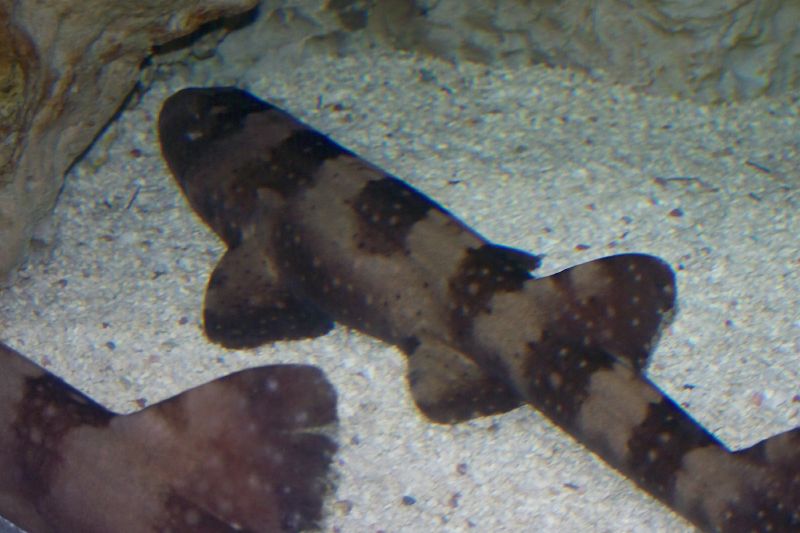 Hello, Frank Indiviglio here. Sharks are not for everyone, but many marine aquarists are tempted to give them a try at some point. Among those available in the trade, the Indo-Pacific’s white-spotted bamboo shark (Chiloscyllium plagiosum) stands out as one of the best. Two slightly larger, boldly-marked species, the brown-banded bamboo shark (C. punctatum) and the epaulette shark (Hemiscyllium ocellatum), are also worth the attentions of serious fish keepers with ample room.
Hello, Frank Indiviglio here. Sharks are not for everyone, but many marine aquarists are tempted to give them a try at some point. Among those available in the trade, the Indo-Pacific’s white-spotted bamboo shark (Chiloscyllium plagiosum) stands out as one of the best. Two slightly larger, boldly-marked species, the brown-banded bamboo shark (C. punctatum) and the epaulette shark (Hemiscyllium ocellatum), are also worth the attentions of serious fish keepers with ample room.
The Aquarium
White-spotted Bamboo Sharks are among the smallest of the regularly available species, rarely exceeding 3 feet in length when full grown. However, they require an aquarium of at least 180 gallon capacity, and preferably larger. Their size and diet (please see below) necessitates that the tank be well-filtered and that regular water changes are carried out.
Please do not make the mistake of believing that a small young shark can be housed indefinitely in a 40 gallon tank – these robust fishes can add 12 or more inches to their length each year! Fertile egg cases are sometimes available in the trade, as captive breeding is fairly regular (parthenogenesis has been documented).
Shelters
Bamboo sharks are often shy when first introduced to a new aquarium, and must be provided with a cave in which to hide. Be aware, however, that they will dig into the sand in an attempt to mold the shelter to their liking, and can in the process dislodge quite heavy items. Rock and coral should be placed on the aquarium’s bottom, and not upon sand, so that the shark cannot burrow below and injure itself.
Compatibility
Bamboo sharks can sometimes be housed with others of their kind, but mature males will fight. Pairs are also difficult to maintain in the same tank, as the male may harass the female continually. They will consume smaller tank mates and may in turn be attacked by certain other fishes, especially puffers and trigger fishes.
Diet
Most aquarists maintain these sharks on a rather limited diet, but ideally they should be offered a wide variety of marine animals, including fishes, shrimps, clams, sand worms, squid, scallops, crabs, conch and mussels. Bait shops and seafood markets are good hunting ground for shark meals. Provide whole, un-cleaned (internal organs or exoskeleton present) animals whenever possible, and remember that a small, whole animal is a more nutritious food item than is a piece of a larger animal.
Bamboo sharks will in time learn to associate you with food. Always use a long feeding tong to offer food or work in their aquarium, as bites can be severe.
Other Sharks
Brown-banded Bamboo Sharks and Epaulette Sharks can be maintained in a similar manner; each sometimes exceeds 4 feet in length, and so a proportionally larger aquarium is needed.
Further Reading
The Florida Museum of Natural History has posted an interesting article on bamboo sharks.
Please write in with your questions and comments.
Thanks, until next time,
Frank Indiviglio
Whitespotted Bamboo shark image referenced from wikipedia and originally posted by yvonne n.
 That Fish Blog – Aquarium Advice and Information
That Fish Blog – Aquarium Advice and Information

Are Wobbegong sharks able to be kept in captivity? They are larger than these Bamboo sharks are they not?
Most Wobbegongs grow to be larger than bamboo sharks, with species ranging from 4 to 11 feet. They can be kept in captivity, but only in a VERY large aquarium, despite their rather sedentary lifestyle. Most aquarists are not able to support a set-up adequate for one of these beautiful sharks, and husbandry should not be attempted in tanks less than 300 gallons even for a small specimen, preferably a tank that will accomodate the shark at adult length…a tank 2 to 2.5 times as long as the shark’s adult length…the bigger the better. So if the species of wobbie is expected to grow to 4 feet, you’d be looking at a tank that would be at least 8-12 feet long, at least 3 feet wide and at least 2-3 feet deep, plus ample filtration and other necessary equipment.
Is it bad if I want to keep it in 180 gallons, or is it okay? Will I be forced to get a bigger one. I just want to check. Just in case a 180 will stunt it’s growth and damage it internally or anything like that.
It’s always better to start out with an adequately sized tank. Many people start out with these and similar fish in smaller tanks, but what if the time comes and you for some reason aren’t able to upgrade? Will the upgrade transition go smoothly and will the chemistry fo the new tank be stable enough to move the shark safely? These are questions to consider. There is no way to predict whether your shark will have a problem if kept too long in a tank that is too small to handle its growth, so its best to provide them with the best possible captive conditions from the start.
how much do white spotted bamboo shark cost.
and what is there life span.
Hello,
Tagged wild individuals have lived to at least age 20; their maximum is likely longer. prices vary greatly by size, location, availability, no general average as far as I can see, I’ll check the next wholesale list I get. best, Frank